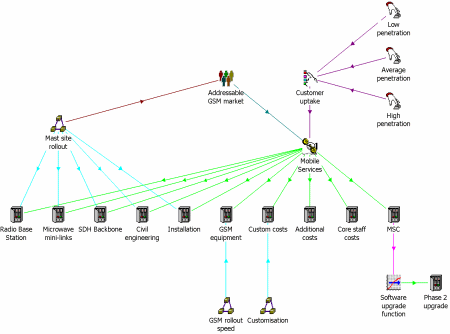Mahindra–British Telecom (MBT) recently helped a mobile operator in Eastern Europe
to review the business case for a significant network expansion. MBT was asked to
validate assumptions, provide key performance data for senior management and external
investors, and to provide a financial model able to track the progress of the investment
through to implementation. Working with best-of-breed partners to deliver leading-edge
software solutions and services to its customers, MBT has licensed the STEM tool as the
cornerstone of its financial modelling services.
Extended GSM coverage and new TETRA network
The client is an important player in the Eastern European mobile communications
market who required an independent evaluation and analysis of their capital investment
plans. Faced with low penetration of both mobile and fixed markets in one particular
region, a significant network expansion was proposed. Outline technical plans had
already been drawn up for the first-phase investment of EUR120 million to extend
GSM coverage, as well as establishing a Terrestrial Trunked Radio (TETRA) network.

Simplified view of GSM network sensitivities
MBT’s STEM-based modelling and analysis enabled the client to validate the expansion
proposal and to measure the impact of a number of critical uncertainties.
Planning an investment decision with various what-if scenarios
MBT worked in close partnership with the client to create a financial model based
on a detailed and accurate view of complex technical and economic relationships,
drawing on known data from the client’s existing mobile network and projections
for the new region. The STEM model gave the client an invaluable and flexible tool
for evaluating their investment decision.
Various ‘what-if’ scenarios were tried and tested through the model, including:
|
Scale
|
Different assumptions for coverage and customer growth.
|
|
Additional investment in a TETRA network
|
Additional build of network infrastructure on existing base station sites increased
capital requirements that had to be justified by marketing the service to a discrete
market segment.
|
|
Phasing of a transfer from managed-service operations
|
Delaying the acquisition of in-house systems enabled long-term debt to be managed
more effectively and reduced the overall risk of the project.
|
|
Impact of delays to roll-out
|
The schedule for the installation of key base station sites was likely to be affected
by seasonal conditions. Initial market penetration could be significantly slowed
down by starting at the wrong time of year, reducing payback on the investment.
This was a critical dimension to explore and will provide valuable analysis as network
roll-out progresses.
|
A complete picture
 The financial model included an inventory for base station,
transmission and core hardware and software, enabling the implementation timetable
to be optimised in line with customer demand and regulatory requirements. The
model analysed the impact of growth in traffic, customer development and upgrades
to the proposed GSM/TETRA service, and included accurate assessments of the impact
of interconnect and other costs. It also considered non-technical implications of
the investment, such as the implementation costs associated with roll-out and consolidation
of the network.
The financial model included an inventory for base station,
transmission and core hardware and software, enabling the implementation timetable
to be optimised in line with customer demand and regulatory requirements. The
model analysed the impact of growth in traffic, customer development and upgrades
to the proposed GSM/TETRA service, and included accurate assessments of the impact
of interconnect and other costs. It also considered non-technical implications of
the investment, such as the implementation costs associated with roll-out and consolidation
of the network.
The market was factored by geography, usage and different types of customer. MBT
provided forecasts for the rate of market penetration and the profit margin that
different types of customer could be expected to generate. The model then calculated
a payback period, internal rate of return and operating margins throughout the project’s
life, as well as long-term and short-term debt profiles.
Challenging assumptions for the sake of better-informed decisions
STEM is an analytical tool which also encourages clarity. The consistent modelling
framework demands a thorough review of all dimensioning angles and may challenge
fundamental assumptions made within a business. The modelling analysis for this
client rapidly identified areas where existing assumptions had been unrealistic
or miscalculated that would otherwise have distorted the investment plan.
Within 20 days of being appointed, MBT had provided the client with a detailed and
accurate techno-economic analysis of the proposal. A precise analysis of both risk
and expected progress was critical as the investment would be partly funded by external
sources. STEM rapidly produced a range of financial measures that addressed investor
concerns over both the risk and viability of the investment.
MBT’s Planning and Inventory business unit
was created to address the evolving challenges of telecoms infrastructure optimisation
faced by global service providers who own and operate their own networks.